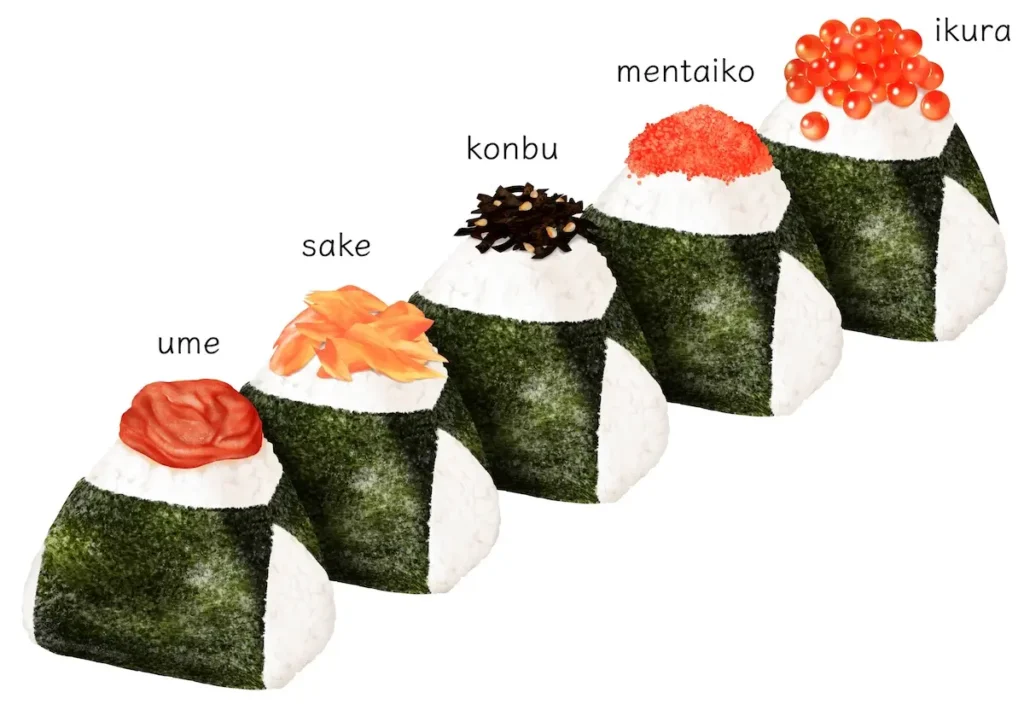
Onigiri – Japan’s Soul Food
The Appeal of Onigiri and Its Special Place in Japanese Life
Onigiri has been a beloved food in Japanese culture for a long time.
It is a simple dish made by shaping rice with your hands.
However, its convenience and delicious taste make it popular across all generations.
For many Japanese people, onigiri is tied to fond memories.
It reminds them of “lunchboxes made by their mothers” or “snacks for school trips.”
Also, onigiri is easy to carry.
Because of this, it is a staple in school and work lunches.
It is also a popular quick meal for busy days.
Furthermore, you can always buy onigiri at convenience stores.
Today, it plays an important role, much like fast food in Japan.
In this article, we will explore the different types of onigiri, their fillings, and related Japanese expressions.
Let’s take a closer look at its many charms.
Onigiri Fillings: A Delicious Variety That Makes Onigiri Irresistible
Popular and Classic Fillings
One of the best things about onigiri is the variety of fillings inside.
The fillings greatly affect the flavor and texture.
The most popular filling at convenience stores is “tuna mayo.”
It is made by mixing tuna (canned tuna flakes) with mayonnaise.
This filling is known for its mild taste and creamy texture.
Besides tuna mayo, here are other classic and popular fillings:
- Ume (pickled plum): Sour and refreshing. A traditional Japanese filling.
- Salmon: Flaked grilled salted salmon. It has a savory and satisfying flavor.
- Ikura (salmon roe): Salmon eggs with a popping texture and salty taste.
- Kombu (kelp): Sweet simmered kelp with a gentle flavor.
- Mentaiko (spicy pollock roe): A spicy filling loved by those who enjoy bold flavors.
Nori and Modern Convenience Store Innovations
Because of the many fillings, you can enjoy onigiri without getting tired of it.
Some shops even offer regionally or seasonally limited flavors.
Also, most onigiri are wrapped in nori (seaweed).
Nori helps keep the rice from drying out and adds aroma and flavor.
Nowadays, some convenience stores sell onigiri where the nori is wrapped just before eating.
This lets you enjoy a crispy texture.
Words and Expressions About Onigiri
- Nigiru” (にぎる) — This means the action of shaping or forming onigiri (rice balls). It’s also used for making sushi by hand, as in “nigiri sushi.”
- “Gu” (具) — The filling inside the onigiri.
Example phrases:
- 「Sake no onigiri wa dore desu ka?」 (Which one is the salmon onigiri?)
- 「Kono onigiri no gu wa nan desu ka?」 (What is the filling inside this onigiri?)
- 「Tsunamayo no onigiri o kudasai.」(I’d like a tuna mayo onigiri, please.)
Why Onigiri Is So Special
Onigiri is a convenient and familiar staple food in Japan.
You can enjoy many different fillings like tuna mayo, ume, and salmon.
The aroma and texture of the seaweed are also part of its charm.
Inside its simple and comforting flavor lies a piece of Japanese culture and language.
◆ Would you like to practice speaking Japanese? ◆
In my lessons, you can use Japanese a lot and learn to speak naturally with me.
Next time, we will explore “Nori Bento” and “Makunouchi Bento.”
These lunchboxes are fun both to look at and to eat.
They offer a great way to experience Japanese lunch culture.
おにぎりの魅力と日本人の思い出
おにぎりは、昔から日本人に親しまれてきた食べ物です。
ご飯を握っただけのシンプルな料理ですが、その手軽さとおいしさから、幅広い世代に愛されています。
特に多くの日本人にとって、おにぎりは思い出の味です。
「お母さんが作ってくれたお弁当」や「遠足のおやつ」といった記憶と結びついています。
また、持ち運びしやすいことも魅力のひとつです。
学校や会社のお弁当、忙しい日の軽食としても人気があります。
さらに、コンビニエンスストアでも気軽に買えるため、現代の生活には欠かせない存在です。
まるで日本のファストフードのような役割を果たしています。
今回は、おにぎりの種類や具材、そして日本語表現とともに、その魅力をくわしく見ていきましょう。
おにぎりの具材
おにぎりの魅力のひとつは、具材の種類がとても豊富なことです。
中に入れる具材によって、味や食感が大きく変わります。
まず、どのコンビニでも人気No.1なのが「ツナマヨ(ツナマヨネーズ)」です。
ツナ(まぐろのフレーク)とマヨネーズを混ぜたもので、やさしい味とクリーミーな食感が特徴です。
他にも、定番の具材には次のようなものがあります。
- 梅(うめ):すっぱくてさっぱり。昔ながらの伝統的な具材です。
- 鮭(さけ):焼いた塩鮭をほぐして入れたもの。香ばしくてボリュームがあります。
- いくら:鮭の卵。プチプチとした食感と塩味が特徴です。
- こんぶ:甘く煮た昆布。やさしい味わいです。
- 明太子(めんたいこ):ピリッと辛いスケトウダラの卵。刺激のある味が好きな人に人気です。
このように、何度食べても飽きないのがおにぎりの楽しいところです。
さらに、お店によっては地域限定や季節限定の具材もあります。
また、多くのおにぎりは「のり(海苔)」で包まれています。
のりにはご飯の乾燥を防ぐ効果があり、香りや味も楽しめます。
最近では、食べる直前にのりを巻くタイプのおにぎりもあります。
パリッとした食感を味わえるのが魅力です。
おにぎりのことばと表現
- 「にぎる」=おにぎりを作る動作のことです。「すしをにぎる」ともいいます。
- 「具(ぐ)」=おにぎりの中に入っているもの。
フレーズ例:
- 鮭(さけ)のおにぎりはどれですか?
- このおにぎりの具はなんですか?
- ツナマヨのおにぎりをください。
こんなところに、おにぎりの魅力
おにぎりは、手軽で親しみのある日本の定番ごはん。ツナマヨや梅、鮭など、いろいろな具材を楽しめて、のりの香りも魅力のひとつです。
やさしい味の中に、日本の文化やことばがつまっています。
次回は、「のり弁」と「幕の内弁当」。
見た目も味も楽しめる、日本のお弁当文化をのぞいてみましょう。



